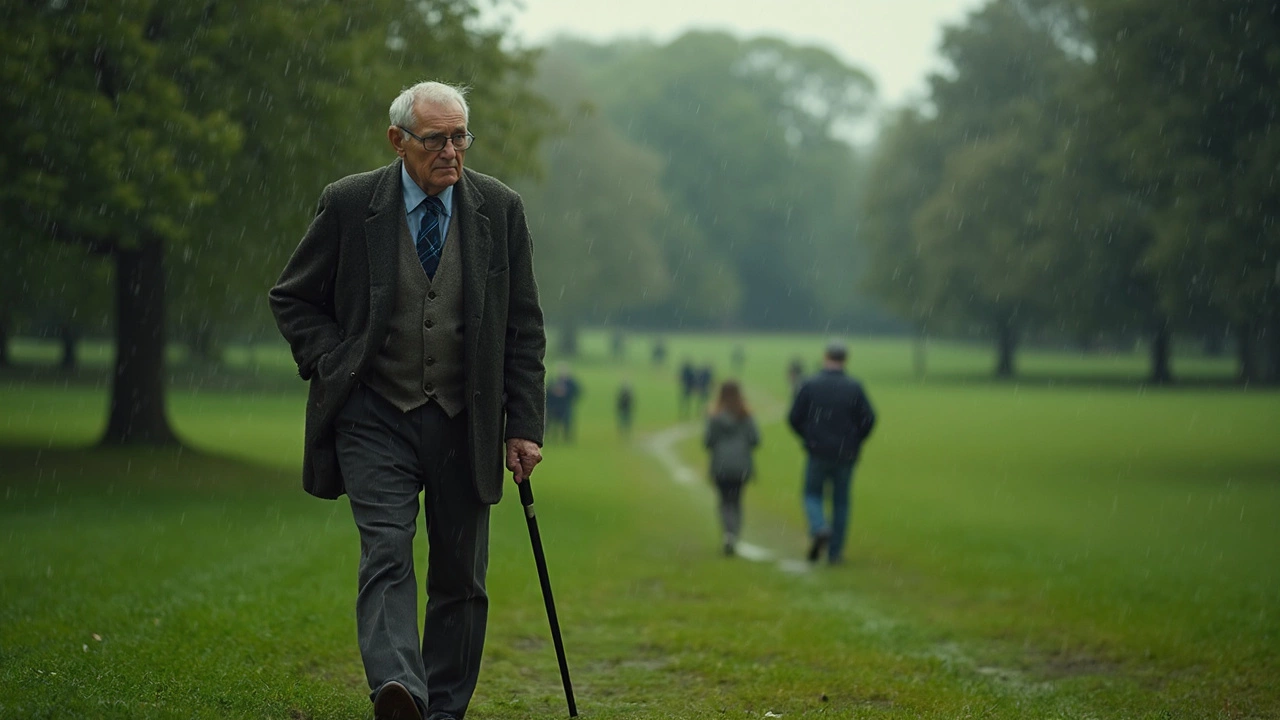 May, 11 2025
May, 11 2025
If you've ever accidentally touched a hot pan or stubbed your toe, you know pain can bring you to your knees fast. But that's nothing compared to what some folks live with every single day. Chronic, brutally intense pain isn’t just a medical term—it’s real life, and for some, it never truly lets up, even for a moment.
Doctors actually have pain scales where ‘ten’ means the worst you can imagine, but there are pains that go way beyond what most people ever experience. Trigeminal neuralgia, known as the 'suicide disease,' is often said to be the worst—imagine lightning bolts in your face, without warning. Then there’s childbirth, kidney stones, complex regional pain syndrome (CRPS), or late-stage cancer pain. All of these have been called the “worst”, and the scariest part is, you might not even see a scratch on the person suffering.
- Pain that Tops the Charts
- The Experience of Chronic Pain
- Not All Pain is Equal
- Ways People Manage the Worst Pain
- Hope for a Better Tomorrow
Pain that Tops the Charts
When people talk about the worst pain out there, a few conditions come up again and again. Trigeminal neuralgia sits at the top. It hits the nerve in your face and is often described as short, electric shocks so fierce it can make even a breeze or chewing agonizing. Many folks with this condition have to plan every part of their day around avoiding flare-ups.
Another rough contender is complex regional pain syndrome (CRPS). This one usually starts after an injury, but the pain just keeps growing—sometimes way out of proportion to what you’d expect. People with CRPS often say their skin feels like it’s on fire, but there’s nothing anyone can see from the outside.
Let’s not forget kidney stones. Passing one can be so excruciating that some women say it rivals (or even beats) childbirth. And yes, childbirth itself is way up there. It’s a pain with a purpose, but that doesn’t make it any less intense in the moment. Late-stage cancer pain, spinal disc herniations, and cluster headaches all make this brutal list, too.
- Trigeminal neuralgia: Called the "suicide disease" for a reason—facial nerve pain with lightning-bolt intensity.
- CRPS: Ongoing, severe burning often triggered by even a minor injury.
- Kidney stones: Sharp pain that can radiate from your back to your groin.
- Cluster headaches: Nicknamed “suicide headaches,” pain comes in cycles and can wake you from sleep.
- Childbirth: Peaks in intensity but thankfully goes away once the baby's born.
The thing is, you can’t measure pain with a ruler. Everyone has their own pain scale, but medical studies often use a 0-10 scale, with 10 as the worst pain ever imagined. These conditions usually rank right at that top spot. They don’t just hurt—they shake your whole life, affecting sleep, work, and even relationships.
The Experience of Chronic Pain
Chronic pain isn’t just a bad day. It’s pain that hangs around for months, sometimes years. Unlike the sharp sting from biting your tongue, this kind won’t quit, even when you’re just sitting still. For millions in the US alone—about 51 million adults, according to CDC data from 2024—it’s a never-ending background noise that messes with every part of life.
What’s it actually like? Imagine waking up already hurting. Simple things, like tying your shoes or lifting a grocery bag, turn into big challenges. Sleep gets choppy, mood sours, and your focus goes out the window. Friends and family might not see anything wrong, but the pain is there, all the time, draining your battery.
Here’s what makes chronic pain tough to manage:
- It can come from injury, nerve damage, or conditions like arthritis or CRPS.
- Pain signals fire even when there’s no real danger or wound left.
- Meds or treatments only help so much—for most, there’s no quick fix.
- Mental health often takes a hit. Rates of depression are double compared to folks without chronic pain.
Check this out—the numbers don’t lie:
| Condition | Percentage of Chronic Pain Sufferers Reporting Severe Pain |
|---|---|
| Trigeminal Neuralgia | Up to 70% |
| CRPS | Over 50% |
| Fibromyalgia | About 30% |
| Arthritis (severe cases) | 20-30% |
The worst part? Pain can steal away hobbies, jobs, even relationships. When I hurt my back as a teenager, I just wanted relief and my energy back—even my dog Charlie and cat Whiskers seemed to sense it. For folks with the worst pain, it’s not just about the ache itself; it’s about the life you lose along the way.

Not All Pain is Equal
Here’s the thing—pain is not a one-size-fits-all kind of deal. You can’t compare a paper cut to nerve damage. Even the same injury can feel totally different for two people. Some pains are sharp and quick, others are deep and relentless, and sometimes the pain just never stops. Nerve pain, like what you get in sciatica or trigeminal neuralgia, isn’t just annoying—it can mess up your entire day, your sleep, and even your mood.
There are two main types: acute pain (like a broken bone or surgery cut), and chronic pain (which sticks around for months, sometimes years). Chronic pain especially can eat away at a person’s ability to work, relax, or enjoy the stuff they love—even simple chores start to feel impossible. And here’s a wild fact: researchers found that 1 in 5 adults worldwide deals with chronic pain. That’s a massive chunk of people walking around hurting every day.
| Pain Type | Duration | Common Causes | Impact |
|---|---|---|---|
| Acute | Short-term | Injury, surgery, infection | Usually resolves as you heal |
| Chronic | 3+ months | Arthritis, nerve damage, CRPS | Affects work, mood, sleep, life quality |
Another thing that makes pain tricky is the way our brains process it. Stress, depression, even bad sleep can crank pain up. What counts as the worst pain is really personal. I’ve watched my own dog Charlie bounce back from a torn paw pretty fast, but my neighbor still can’t sit comfortably after a slipped disc months ago. You can’t measure pain with a ruler or MRI—you have to listen to the person feeling it.
- Sharp pain (stabbing or electric shocks) is well known in nerve injuries.
- Dull, aching pain (like bad arthritis) strains the mind and body over time.
- Burning or tingling pain can make simple stuff—like putting on socks—feel impossible.
Pain isn’t just a physical thing to crush with pills. The toughest types are mysterious, stubborn, or straight-up invisible to anyone else. So when you hear about someone living with a painful condition, remember: not all pain looks the same, and not all pain gets better with time.
Ways People Manage the Worst Pain
When pain refuses to leave, the fight gets real. People with the worst pain will usually try a mix of treatments, because there’s rarely a single fix that works for everyone. Doctors recommend layering different solutions—not just popping pills and hoping for the best.
Pain meds do help, but it’s more complicated than grabbing some ibuprofen. Here’s a look at what’s actually being used out there, and what works best for stubborn, chronic pain:
- Prescription medication: Opioids, nerve pain meds like gabapentin or pregabalin, and sometimes antidepressants that target pain signals. These have serious side effects and dependency risks, so doctors try to use them carefully.
- Physical therapy: Simple movement routines can help retrain the body and brain to handle pain differently. The process is slow but can show real results over months.
- Interventional pain procedures: These include nerve blocks or spinal cord stimulators. For some folks, especially with nerve pain like CRPS or trigeminal neuralgia, this can lower pain intensity a lot.
- TENS units: These portable gadgets send tiny electrical pulses into the skin. Some people swear by them for taking the edge off daily pain.
- Alternative therapies: Acupuncture, massage, and even mindfulness meditation are shown to help—especially when combined with other treatments.
It’s not just about meds and doctors, though. Small life tweaks make a difference. Avoiding triggers like stress and sleep problems, using heat or cold packs, and sticking to a pain diary to track patterns—these can all give a sense of control back to the person hurting.
| Pain Management Method | % of Chronic Pain Patients Using (US, 2023) |
|---|---|
| Prescription Meds | 54% |
| Physical Therapy | 37% |
| Alternative Therapies | 29% |
| TENS/Devices | 14% |
| Pain Procedures | 11% |
Support from other people matters, too. No technique erases pain completely, and it can get lonely battling something invisible. Support groups—online or local—are huge for sharing tricks that actually work. At my place, even Charlie (my dog) and Whiskers (my cat) seem to know when I’m not feeling great, always ready to keep things a little lighter. Sometimes the best “treatment” is just not going it alone.

Hope for a Better Tomorrow
It can feel impossible when you’re stuck in a pain loop, but it’s not all bad news. New research is changing how we fight the worst pain, even the kind that sticks around for years. The latest numbers from the CDC say about 20% of adults in the US are living with chronic pain. That’s a lot of people—and a whole lot of brainpower being used to find better solutions.
Smart doctors and scientists aren’t just handing out pills anymore. Treatments like nerve blocks, electrical nerve stimulation, and physical therapy work for some folks. Others find relief with psychological support, mindfulness training, or group therapy. Pain clinics are popping up everywhere, offering a whole team approach instead of just telling you to "tough it out."
"Sometimes, hope doesn’t come from removing pain, but from learning how to manage it and take back your life. That’s a win too." — Dr. Rachel Zoffness, pain psychologist and educator
Here’s a real-world look at some options people try:
- Physical therapy exercises, especially for nerve pain or CRPS
- Transcutaneous electrical nerve stimulation (TENS)
- Cognitive-behavioral therapy (CBT)—helps retrain your brain’s pain response
- Medications, including some antidepressants that target nerve pathways
- Pain support groups (online or in your town)—proven to boost hope
Below is a quick stat roundup of treatment results:
| Treatment | Chance of Significant Relief |
|---|---|
| Physical Therapy | 30-40%* |
| Nerve Blocks | 40-60% (temporarily) |
| CBT | About 25% see major quality-of-life improvement |
| TENS | 20-40% (depends on pain type) |
*Numbers can vary by individual and pain condition.
Hope isn’t fluffy nonsense. Finding the right mix of treatments, plus a team that listens, has helped tons of people dial their pain way down. Even if a cure isn’t here yet, you don’t have to just suffer in silence.
